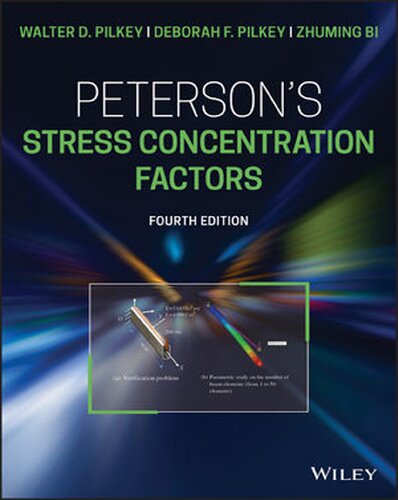

Most ebook files are in PDF format, so you can easily read them using various software such as Foxit Reader or directly on the Google Chrome browser.
Some ebook files are released by publishers in other formats such as .awz, .mobi, .epub, .fb2, etc. You may need to install specific software to read these formats on mobile/PC, such as Calibre.
Please read the tutorial at this link. https://ebooknice.com/page/post?id=faq
We offer FREE conversion to the popular formats you request; however, this may take some time. Therefore, right after payment, please email us, and we will try to provide the service as quickly as possible.
For some exceptional file formats or broken links (if any), please refrain from opening any disputes. Instead, email us first, and we will try to assist within a maximum of 6 hours.
EbookNice Team

Status:
Available5.0
26 reviews
ISBN-10 : 9781119532514
ISBN-13 : 9781119532514
Author: Walter D. Pilkey, Deborah F. Pilkey, Zhuming Bi 1119532515
This book establishes and maintains a system of data classification for all the applications of stress and strain analysis, and expedites their synthesis into CAD applications. Filled with all of the latest developments in stress and strain analysis, this Fourth Edition presents stress concentration factors both graphically and with formulas, and the illustrated index allows readers to identify structures and shapes of interest based on the geometry and loading of the location of a stress concentration factor.
Peterson's Stress Concentration Factors, Fourth Edition includes a thorough introduction of the theory and methods for static and fatigue design, quantification of stress and strain, research on stress concentration factors for weld joints and composite materials, and a new introduction to the systematic stress analysis approach using Finite Element Analysis (FEA). From notches and grooves to shoulder fillets and holes, readers will learn everything they need to know about stress concentration in one single volume.
CHAPTER 1: FUNDAMENTALS OF STRESS ANALYSIS
1.1 STRESS ANALYSIS IN PRODUCT DESIGN
1.2 SOLID OBJECTS UNDER LOADS
1.3 TYPES OF MATERIALS
1.4 MATERIALS PROPERTIES AND TESTING
1.5 STATIC AND FATIGUE FAILURES
1.6 UNCERTAINTIES, SAFETY FACTORS, AND PROBABILITIES
1.7 STRESS ANALYSIS OF MECHANICAL STRUCTURES
1.8 FAILURE CRITERIA OF MATERIALS
1.9 STRESS CONCENTRATION
1.10 STRESS CONCENTRATION AS A TWO-DIMENSIONAL PROBLEM
1.11 STRESS CONCENTRATION AS A THREE-DIMENSIONAL PROBLEM
1.12 PLANE AND AXISYMMETRIC PROBLEMS
1.13 LOCAL AND NONLOCAL STRESS CONCENTRATION
1.14 MULTIPLE STRESS CONCENTRATION
1.15 PRINCIPLE OF SUPERPOSITION FOR COMBINED LOADS
1.16 NOTCH SENSITIVITY
1.17 DESIGN RELATIONS FOR STATIC STRESS
1.18 DESIGN RELATIONS FOR ALTERNATING STRESS
1.19 DESIGN RELATIONS FOR COMBINED ALTERNATING AND STATIC STRESSES
1.20 LIMITED NUMBER OF CYCLES OF ALTERNATING STRESS
1.21 STRESS CONCENTRATION FACTORS AND STRESS INTENSITY FACTORS
1.22 SELECTION OF SAFETY FACTORS
REFERENCES
NOTES
CHAPTER 2: NOTCHES AND GROOVES
2.1 NOTATION
2.2 STRESS CONCENTRATION FACTORS
2.3 NOTCHES IN TENSION
2.4 DEPRESSIONS IN TENSION
2.5 GROOVES IN TENSION
2.6 BENDING OF THIN BEAMS WITH NOTCHES
2.7 BENDING OF PLATES WITH NOTCHES
2.8 BENDING OF SOLIDS WITH GROOVES
2.9 DIRECT SHEAR AND TORSION
2.10 TEST SPECIMEN DESIGN FOR MAXIMUM KT FOR A GIVEN R/D OR R/H
REFERENCES
NOTES
CHAPTER 3: SHOULDER FILLETS
3.1 NOTATION
3.2 STRESS CONCENTRATION FACTORS
3.3 TENSION (AXIAL LOADING)
3.4 BENDING
3.5 TORSION
3.6 METHODS OF REDUCING STRESS CONCENTRATION AT A SHOULDER
REFERENCES
CHAPTER 4: HOLES
4.1 NOTATION
4.2 STRESS CONCENTRATION FACTORS
4.3 CIRCULAR HOLES WITH IN-PLANE STRESSES
4.4 ELLIPTICAL HOLES IN TENSION
4.5 VARIOUS CONFIGURATIONS WITH IN-PLANE STRESSES
4.6 HOLES IN THICK ELEMENTS
4.7 ORTHOTROPIC THIN MEMBERS
4.8 BENDING
4.9 SHEAR AND TORSION
REFERENCES
NOTE
CHAPTER 5: MISCELLANEOUS DESIGN ELEMENTS
5.1 NOTATION
5.2 SHAFT WITH KEYSEAT
5.3 SPLINED SHAFT IN TORSION
5.4 GEAR TEETH
5.5 PRESS- OR SHRINK-FITTED MEMBERS
5.6 BOLT AND NUT
5.7 BOLT HEAD, TURBINE-BLADE, OR COMPRESSOR-BLADE FASTENING (T-HEAD)
5.8 LUG JOINT
5.9 CURVED BAR
5.10 HELICAL SPRING
5.11 CRANKSHAFT
5.12 CRANE HOOK
5.13 U-SHAPED MEMBER
5.14 ANGLE AND BOX SECTIONS
5.15 CYLINDRICAL PRESSURE VESSEL WITH TORISPHERICAL ENDS
5.16 WELDS
5.17 PARTS WITH INHOMOGENEOUS MATERIALS OR COMPOSITES
5.18 PARTS WITH DEFECTS
5.19 PARTS WITH THREADS
5.20 FRAME STIFFENERS
5.21 DISCONTINUITIES WITH ADDITIONAL CONSIDERATIONS
5.22 PHARMACEUTICAL TABLETS WITH HOLES
5.23 PARTS WITH RESIDUAL STRESSES
5.24 SURFACE ROUGHNESS
5.25 NEW APPROACHES FOR PARAMETRIC STUDIES
REFERENCES
CHAPTER 6: FINITE ELEMENT ANALYSIS (FEA) FOR STRESS ANALYSIS
6.1 STRUCTURAL ANALYSIS PROBLEMS
6.2 TYPES OF ENGINEERING ANALYSIS METHODS
6.3 STRUCTURAL ANALYSIS THEORY
6.4 FINITE ELEMENT ANLAYSIS (FEA) FOR STRUCTURAL ANALYSIS
6.5 PLANNING V&V IN FEA MODELING
6.6 FINITE ELEMENT ANALYSIS FOR VERIFICATION OF STRUCTURAL ANALYSIS
6.7 FEA FOR STRESS ANALYSIS OF ASSEMBLY MODELS
6.8 PARAMETRIC STUDY FOR STRESS ANALYSIS
6.9 FEA ON STUDY OF STRESS CONCENTRATION FACTORS
stress concentration factor around a circular hole
factors affecting time of concentration
concentration factor in ro
concentration factor in geology
concentration factor of ro membrane
Tags: Petersons Stress, Concentration Factors, Walter Pilkey, Deborah Pilkey, Zhuming Bi